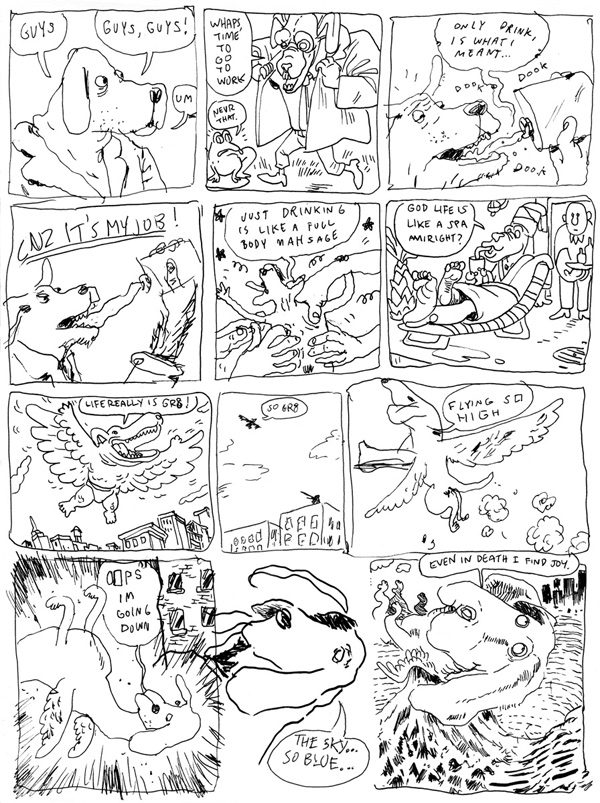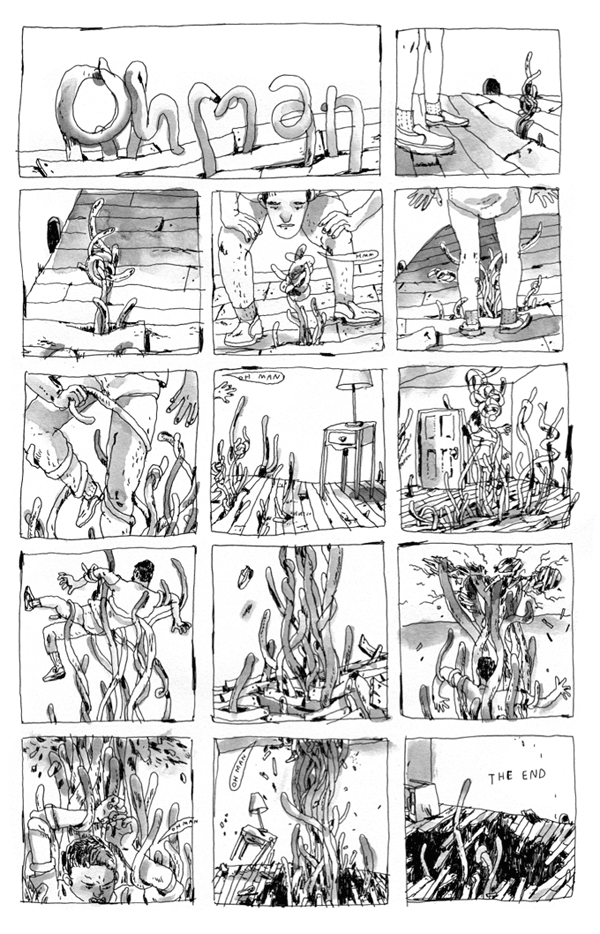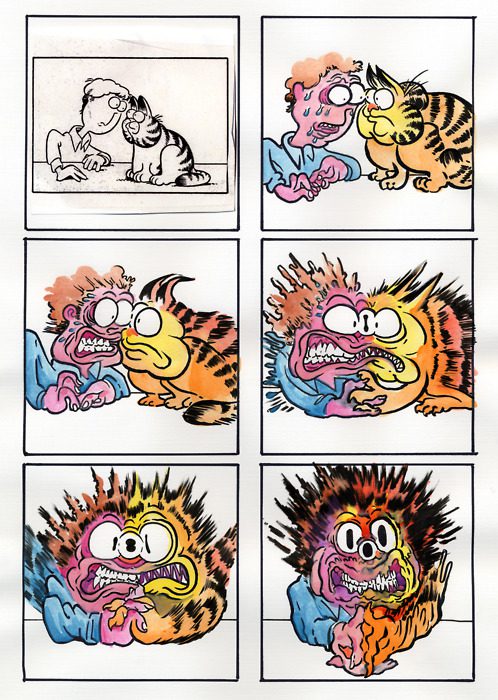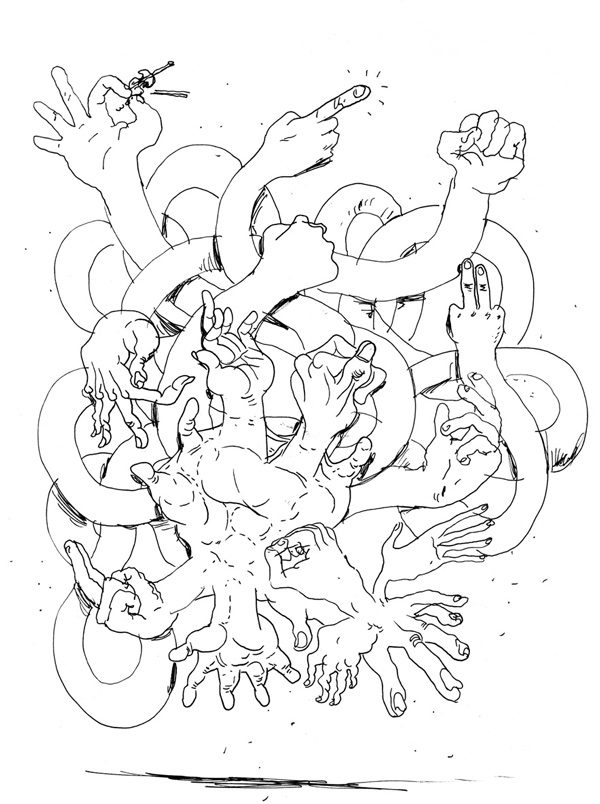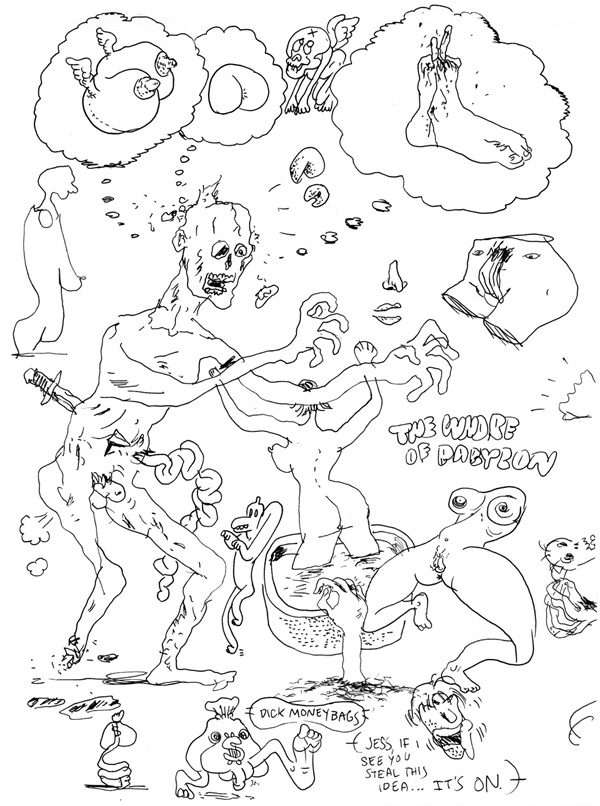I recently sat down for burgers, beers and conversation with Josh Burggraf and Victor Kerlow, cartoonists who are close friends.
Burggraf is the cartoonist behind a bevy of comics including Kid Space Heater and the anthology Future Shock. He works for an advertising firm during the day. Kerlow is a freelance illustrator with clients such as The New Yorker and The New York Times. His new comics collection Everything Takes Forever was recently released by Koyama Press. We started in talking about dogs and other people’s signatures and why Alec Baldwin is famous, and drew a jam comic while we spoke.
***
Jess Worby for The Rumpus: Do you guys draw compulsively?
Josh Burggraf: You know we do.
Victor Kerlow: I walked in here and was like “DUUUUDE LET’S START A JAM.” I haven’t drawn in– what? Like two hours?
Rumpus: But not all cartoonists do. Isn’t that weird?
Kerlow: Well, we love to draw together.
Burggraf: But yeah, lots of people I know don’t.
Kerlow: With Josh, I’m more inclined to just start drawing. But I’m totally over the whole “I love to draw, so let me draw right now.” Like, I’m eating dinner, so let me draw my sandwich.
Rumpus: You mean like observational stuff?
Kerlow: No, no– I mean this false impulse to draw all the time. I love to draw. I do it every day. Sometimes I don’t want to. I draw every day, for work, the way I want to, so I’m less inclined now as a professional to do personal work. The work I do, I legitimately enjoy it.
Rumpus: Are you ever working on a freelance illustration project, and you just hate it so much that you don’t want to work on it anymore?
Kerlow: Never.
Rumpus: You never feel like, “Oh, I just wanna draw my own thing.”
Kerlow: Never. Because, man– my “own thing” is having a life where I can draw stuff.
Burggraf: He just always draws the way he draws. It’s not like he’s somehow outside of himself.
Kerlow: When I worked where Josh works, I was much more prolific in my comic making. Neither of us are interested in doing “art” though.
Rumpus: What do you mean by that?
Kerlow: We’re not trying to do a drawing that means something– we’re trying to tell a fun story and have a fun time.
Burggraf: It is more about storytelling than it is about making an art object.
Kerlow: If I make a big oil painting of a phone, I can bullshit for 30 hours about it, but…
Rumpus: I hear that.
Kerlow: But the best part of commercial art is that–
Burggraf: –there’s no pretense.
Kerlow: Yeah, it’s exactly that. You do it and it’s done. The end. Next job. I don’t even need to be that good a drawer to be doing the work I’m doing. There are people much more successful than I am that are bad at drawing, and I’m not saying that in a negative way, just that sometimes it’s more idea driven, which is fun. And it’s not just based on your own idea, so you never have to take responsibility for it, which is the best part.
(laughter)
Burggraf: I take that to the furthest degree possible. Victor is responsible for bringing his own style to it, but where I work, I’m tracing photos; it doesn’t look like me at all, and that’s good. I’m happy to just give it all up.
Rumpus: That feels good?
Burggraf: Absolutely. I used to stress out doing storyboards and shit. I mean, it’s still a challenge. You still have to make it look nice, but it’s not me in any way. Other people have to care about what they make– I don’t. So I have all this energy when I get home, so it is like an itch for me. I need to always be drawing. Unless I’m on vacation.
Kerlow: You take vacations. Most people don’t take vacations.
Burggraf: Eh, well–
Kerlow: The cool thing for me is, I can go on vacation. I can go somewhere and be on vacation, but I’m still working. That’s not a real vacation for me, because my whole life is a vacation.
Rumpus: You’re living the dream, man.
Kerlow: Dude, do you ever hear me complain about my life?
Rumpus: No, I never hear you complain about your life.
Burggraf: Never.
Kerlow: Never.
Rumpus: I admire that.
Kerlow: You get to finish a work week every day. Each time you get a project, you do it and you’re done with it, which is awesome.
Burggraf: I don’t work as fast as him.
Kerlow: You mean per piece?
Burggraf: Yeah.
Kerlow: You totally make more comics than I do though.
Burggraf: Well, you went through that slump for like, two years.
Kerlow: Yeah, and you were cranking them out. But now I’m feeling pretty good. I’ve got this comic coming out [Everything Takes Forever, available now from Koyama Press]. And then I did that one for you.
Burggraf: Oh yeah. For Future Shock 4. We can plug that. I edited it. He’s in it.
Rumpus: How did Future Shock start?
Burggraf: I think I wanted to make something like an anthology book of my own stuff. It started as just me and a couple people, and now it’s me and like forty pages of other people.
Kerlow: Josh’s favorite things to draw became the theme of the magazine. Other people like to draw that stuff, too, so it worked out.
Burggraf: It didn’t start with a theme though. I just wanted to put something out. To be fair, Victor got me into comics again. I had given up on them and he was just always making shit. His stuff and the Rabid Rabbit books.
Rumpus: What were you doing at the time?
Burggraf: I was working where I am now, but he was making a comic a week.
Kerlow: I made something like one personal color anthology every six months. It was fun. I had a friend who worked at a printing company then. I don’t do that anymore. Small Victories came out, what– a year ago [from Birdcage Bottom Books]?
Burggraf: Steve Fuentes is the other piece of the puzzle.
Kerlow: Yeah, Steve. He brought a sketchbook around MoCCA in 2006 and got people to draw a jam comic. We got maybe four people to send $1 to my apartment for it. They were awesome. Charles Burns did a panel with a creature Steve had drawn. Anders Nilsen did a panel after Peter Cho or someone.
Burggraf: Steve gets really aggressive with his jams.
…
Next came what would come to be known as “the lost session”. We talked about comics. We talked about art. We talked about life. We talked about love. None of this made it into my recording, of course. Here are some notes:
– The two use color in very different ways: Burggraf does a lot of color studies to help determine a palette for each comic, whereas Kerlow colors more spontaneously, which works in concert with a more realistic palette.
– Burggraf will sometimes pencil his comics out before the finals, whereas Kerlow likes to jump straight in with the ink, because he thinks his drawings look dead without that spontaneity. He occasionally makes small thumbnail sketches of his panels though.
– Annie Koyama is the best.
I restarted the recording at this point.
…
Rumpus: Josh, when you’re doing that Tumblr stuff, that’s all improvised, right? That six-panel stuff?
Burggraf: Yeah, usually. Victor was saying before how he just makes up stories on the spot. I make up stories for those, because I usually try to plot everything out too much. He was saying that comics aren’t even about the drawing a lot of the time, they’re about the story. For a while, it was just about the drawings for me. I would get a visual idea, like a fish exploding, and then I’d build a whole comic around that.
Rumpus: I think a lot of cartoonists do that.
Burggraf: They do! But these days, the biggest note I get is “your stories aren’t as strong.” So I’ve been trying to figure out how to write them. Recently I’ve done a bunch of comics about making comics, because it’s what I know.
 Burggraf: Yeah, the one about ideas. You can have five thousand ideas a day. But by the time you sit down to make the thing, you’re already onto the next idea.
Burggraf: Yeah, the one about ideas. You can have five thousand ideas a day. But by the time you sit down to make the thing, you’re already onto the next idea.
Kerlow: Yeah, that’s why I don’t like to pencil. If you’re gonna make a drawing, then just make a [final] drawing. It’s done.
Rumpus: Then why don’t you just write?
Kerlow: I’ve done that. I’m not really interested in being a novelist or a short story writer though. When you write and you think about stuff, you try to make it about something meaningful, and what’s meaningful? It’s a lot of depressing stuff, right? But how am I gonna go write about just… just a great day. I can’t go write about a great day. It’s boring. I gotta make a comic.
Rumpus: But the feedback loop that happens from writing–
Kerlow: Right. It can feed back into your comics. I mean, you just write a story because you feel like doing it. You make comics because you feel like doing it. That’s all. I wrote one story about this dude just pissing his pants. If I drew it, it would be funny, but it wasn’t supposed to be funny, so I didn’t. Visual aids can be hindrances, too. Drawings don’t always clarify things.
Rumpus: No, sometimes people will try to use drawing to fill the hole where there’s a lack of story.
Kerlow: Right. So when I write, it’s just writing. I don’t always have to make it into a comic. You know what else is fun? I wrote this one story for Josh to draw.
Burggraf: Oh yeah. That was a good story.
Kerlow: I don’t think it’s gonna make a good comic though. It doesn’t need visual accompaniment.
Burggraf: I could see that. A lot of visuals have already been explained in the writing. This is the only part where I disagree with you: I think you have to fuse the visual with the story. You have to make sure that they’re both towing it, instead of just one. You can’t just adapt this, adapt that, because of its story. You should make something that exists in its own medium.
Rumpus: You could even be good at writing and good at drawing and not be a good cartoonist. It’s a whole other skill.
Burggraf: Yeah, totally.
Rumpus: Do you think empathy is important for making things?
Kerlow: It’s important to make comics with a theme people can connect with.
Burggraf: It’s less about empathy and more about like, “have you put yourself in it?” Some people make comics, and they’re cold and calculating, because that’s how those people are. So there’s no empathy, but they’re still putting themselves into it.
Rumpus: Josh has done a lot– and Victor, you did a couple, too– comics dealing with physical transformation.
Kerlow: Oh yeah, the Dada morph comic. Those are the real visually driven comics– Like R. Crumb melting– that’s the best comic, because it’s just… done. It’s like it was a gif before gifs existed.
Burggraf: Yeah! My most popular comic that I’ve made, hands down, is the one of Garfield turning into Nancy.
…
At this point we all started drawing hands from memory and talking about the part memory plays in drawing.
Burggraf: What Victor does so well here is he draws a cartoon that is somehow grounded fully in reality. My drawings are always just cartoons.
Rumpus: Victor and I don’t generalize form like you generalize form. I think it has to do with visual memory. When I was a kid I remembered all sorts of weird visual details.
Burggraf: I did not.
Rumpus: I can tell Victor has a good visual memory.
Kerlow: When I was a kid I had a photographic memory, no joke.
Rumpus: Let’s talk about influences.
Kerlow: Groan. I’ve tried to destroy any influences that someone could see in my work stylistically. I mean, who did I like in high school? Klimt and Schiele? I mainly absorbed ways of thinking about drawing. There are like five people whose stuff looks like mine anyway. After years of being in school and people asking you that question, you just want to say “no one”, rather than tell them and then have them be like “oh, now I see it.”
Rumpus: Maybe this is more the case with illustration, but so often you see work that’s an obvious mimic of someone, or a blend of these two people…
Burggraf: But even if you’re doing your own thing and it’s great, people are going to say, “you’re like a child of this and that person”, because it helps them understand what you’re doing.
Rumpus: Exactly. And it can be a fun exercise to copy someone’s work, you learn from it as you’re doing it, but just for studies– not for final stuff.
Burggraf: I did, at one point, start deliberately making Jack Kirby drawings. Because I had gotten so into my own head that my drawings weren’t expanding anymore.
…
Rumpus: If you were a Seinfeld character, who would you be?
Kerlow: Um, I’d be the best one.
Rumpus: You’d be Kramer.
Kerlow: Is he the best one?
Rumpus: I don’t know, but you’d be Kramer.
***
First Image: “Jam Comic” by Josh Burggraf, Victor Kerlow, and Jess Worby
Second Image: “Big Crocodile Tears” by Victor Kerlow
Third Image: “Oh Man” by Victor Kerlow, from Everything Takes Forever, published by Koyama Press
Fourth Image: A page from a comic by Josh Burggraf, published in Future Shock 4
Fifth Image: A comic by Josh Burggraf, published in Suspect Device 2
Sixth Image: Hands, by Josh Burggraf, Victor Kerlow, and Jess Worby
Seventh Image: The Whore of Zombilon, by Josh Burggraf, Victor Kerlow, and Jess Worby
_______________
Jess Worby is a visual artist, illustrator, teacher, curator and cartoonist living in Brooklyn. Keep up with his artistic exploits on everythingisweird.com and his musings on Twitter.

